B.D. Wright
Veterinary Anesthesiologist — Integrative Pain Management Specialist, Mistralvet.com
Recognition and Assessment of Acute Pain in Cats
Acute pain is the result of a traumatic, surgical, medical or infectious event that begins abruptly and should be relatively brief. This pain can usually be alleviated by the correct choice of analgesic drugs, most commonly opioids and nonsteroidal anti-inflammatory drugs (NSAIDs). For successful relief of pain, one must first look for it and recognize it. It is recommended that assessment of pain is incorporated into Temperature, Pulse and Respiration (TPR) examinations, making pain the 4th vital sign we monitor. Cats that have been injured or undergone surgery should be monitored closely and pain must be treated promptly to prevent it from escalating. Treatment must be continued until the acute inflammatory response abates. The degree of trauma dictates the intensity and duration of the inflammatory response, but treatment may be required for several days. Feral cats require preemptive administration of analgesics based on the severity of the proposed surgical procedure rather than based on their behaviour; in addition, interactive pain assessment is not possible in this population.
Neuroendocrine assays measuring β-endorphin, catecholamines and cortisol concentrations in plasma have been correlated with acute pain in cats; however, these are also influenced by other factors such as anxiety, stress, fear and drugs. Currently there is no validated pain-scoring system for use in cats. Objective measurements, such as heart rate, pupil size and respiratory rate, have not been consistently correlated with signs of pain in cats – therefore we depend on subjective evaluation based on behaviour.
Pain Assessment and Recognition
Take into consideration the type, anatomical location and duration of surgery, the environment, individual variation, age, and health status. The cat should be observed from a distance then, if possible, the caregiver should interact with the cat and palpate the painful area to fully assess the cat’s pain. A good knowledge of the cat’s normal behaviour is very helpful as changes in behaviour (absence of normal behaviours such as grooming and climbing into the litter box) and presence of new behaviours (a previously friendly cat becoming aggressive, hiding or trying to escape) may provide helpful clues. Some cats may not display clear overt behaviours indicative of pain, especially in the presence of human beings, other animals or in stressful situations. Cats should not be awakened to check their pain status; rest and sleep are good signs of comfort but one should ensure the cat is resting or sleeping in a normal posture (relaxed, curled up). In some cases, cats will remain very still because they are afraid or it is too painful to move, and some cats feign sleep when stressed.
Facial Expressions and Postures
These can be altered in cats experiencing pain: furrowed brow, orbital squeezing (squinted eyes) and a hanging head (head down) can be indicators of pain. Following abdominal surgery, a hunched position and/or a tense abdomen is indicative of pain. Abnormal gait or shifting of weight and sitting or lying in abnormal positions may reflect discomfort and protection of an injured area. Comfortable cats should display normal facial expressions, postures and movement after successful analgesic therapy. Figures 1A,B,C,D,E provide examples of normal postures and facial expressions and those that may be indicative of pain.
| Figure 1A. A cat with a normal posture | 
The cat’s head is up, the cat is alert and the eyes are open. |
|
| |
| Figure 1B. A cat resting after surgery in a normal relaxed and curled-up position | 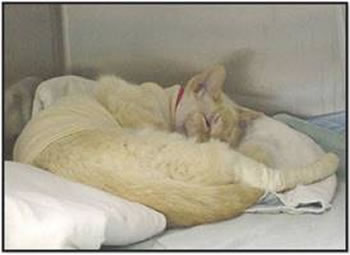
|
|
| |
| Figure 1C. This cat is ‘flat out’ and tense after surgery | 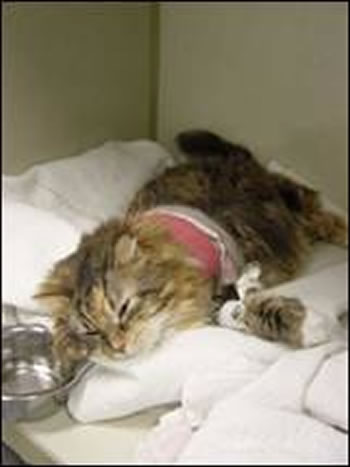
Also note the facial expression. |
|
| |
| Figure 1D. This cat has had abdominal surgery | 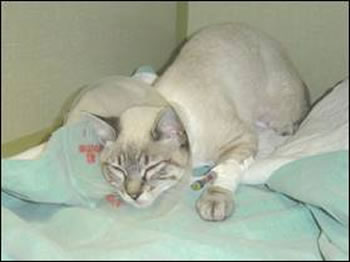
The hunched posture and low hung head are suggestive of pain. Note also that the eyes are either held shut or half closed and appear “slanted” or “squinted” compared to the cat in Figure 1A. |
|
| |
| Figure 1E. This cat has had abdominal surgery | 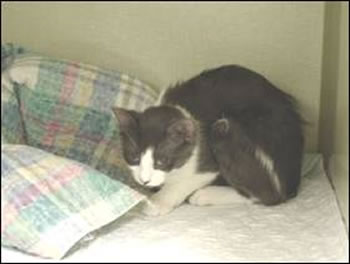
The hunched posture and low hung head are suggestive of pain. Note also that the eyes are either held shut or half closed and appear “slanted” or “squinted” compared to the cat in Figure 1A. |
|
| |
Behavioural Changes Associated with Acute Pain in Cats
Reduced activity, loss of appetite, quietness, hiding, hissing and growling (vocalization), excessive licking of a specific area of the body (usually involving surgical wounds), guarding behaviour, cessation of grooming, tail flicking and aggression may be observed. Cats in severe pain are usually depressed, immobile and silent. They will appear tense and distant from their environment.
Dysphoria versus Pain
Thrashing, restlessness and continuous activity can be signs of severe pain in cats. However, these can also be related to dysphoria. Dysphoria is usually restricted to the early postoperative period (20–30 min) and/or associated with poor anaesthetic recoveries after inhalant anaesthesia and/or ketamine administration and/or after high doses of opioids. Hyperthermia associated with the administration of hydromorphone and some other opioids may lead to anxiety and signs of agitation in cats.
Recognition and Assessment of Acute Pain in Dogs
Acute pain occurs commonly in dogs as a result of a trauma, surgery, medical problems, infections or inflammatory disease. The severity of pain can range from very mild to very severe. The duration of pain can be expected to be from a few hours to several days. It is generally well managed by the use of analgesic drugs. The effective management of pain relies on the ability of the veterinarian, animal health technician and veterinary nurse to recognize pain, and assess and measure it in a reliable manner. When the dog is discharged home, owners should be given guidance on signs of pain and how to treat it.
Objective measurements including heart rate, arterial blood pressure and plasma cortisol and catecholamine levels have been associated with acute pain in dogs;11 however, they are unreliable since stress, fear and anaesthetic drugs affect them. Thus, evaluation of pain in dogs is primarily subjective and based on behavioural signs.
Pain Recognition
Behavioural expression of pain is species-specific and is influenced by age, breed, individual temperament and the presence of additional stressors such as anxiety or fear. Debilitating disease can dramatically reduce the range of behavioural indicators of pain that the animal would normally show (e.g., dogs may not vocalize and may be reluctant to move to prevent worsening pain. Therefore, when assessing a dog for pain a range of factors should be considered, including the type, anatomical location and duration of surgery, the medical problem, or extent of injury. It is helpful to know the dog’s normal behaviour; however, this is not always practical and strangers, other dogs, and many analgesic and other drugs (e.g., sedatives) may inhibit the dog’s normal behavioural repertoire.
Behavioural signs of pain in dogs include:
- Change in posture or body position (Figures 2 and 3)
| Figure 2. (A) Post-laparotomy; (B) severe dermatitis | 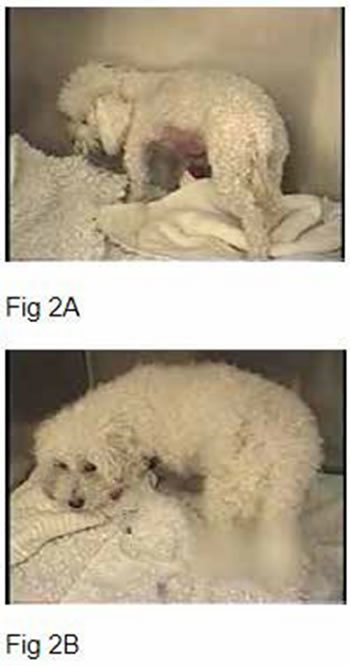
|
|
| |
| Figure 3. Gastroesophageal pain | 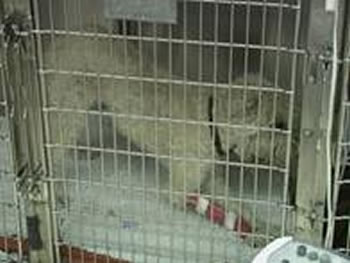
|
|
| |
- Change in demeanour (Figure 4)
| Figure 4A. Pancreatitis, painful | 
|
|
| |
| Figure 4B. Pancreatitis, pain free | 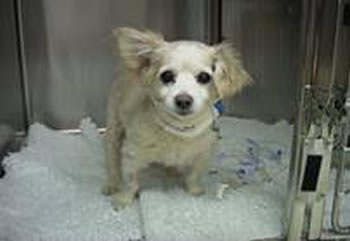
|
|
| |
- Vocalization
- Altered reaction to touch
- Altered interaction with people (e.g., reduced interaction, aggression)
- Altered mobility (e.g., lameness, reluctance to move)
- Reduction in appetite
Pain Assessment Protocol
The most important step in managingacute pain well is to actively assess the dog for signs of pain on a regular basis, and use the outcomes of these assessments (through observation and interaction) along with knowledge of the disease/surgical status and history of the animal to make a judgement on the pain state of the dog. It is recommended that carers adopt a specific protocol and approach every dog in a consistent manner to assess them for pain. Dysphoria should be considered where panting, nausea, vomiting or vocalization occurs immediately following opioid administration.
- Observe the dog in its kennel/bed and consider its demeanor and posture
- Approach the dog and interact with it, calling its name, and consider its response
- Touch the dog (around a wound/damaged tissue as appropriate), and consider its response (normal, aggressive, flinching, etc.).
Where a dog is judged to be in pain, treatment should be given immediately to provide relief. Dogs should be assessed continuously to ensure that treatment has been effective, and thereafter on a 2–4 hourly basis.
Pain measurement tools: these should possess the key properties of validity, reliability and sensitivity to change.
Pain is an abstract construct so there is no gold standard for measurement and since the goal is to measure the affective component of pain (i.e., how it makes the dog feel), this is a real challenge. This is further compounded by the use of an observer to rate the dog’s pain. Few of the scales available for use in dogs have been fully validated. Simple unidimensional scales, including the Numerical Rating Scale (NRS), the Visual Analogue Scale (VAS) and the Simple Descriptive Scale (SDS) (Figure 5), have been used.12,13 These scales require the user to record a subjective score for pain intensity. When using these scales, the observer’s judgment can be affected by factors such as age, gender, personal health and clinical experience, thus introducing a degree of interobserver variability and limiting the reliability of the scale. However, when used consistently, these are effective as part of a protocol to evaluate pain as described above. Of the three types of scales described (and there are others in this category), the NRS (0 to 10) is recommended for use due to its enhanced sensitivity over the SDS and increased reliability over the VAS.
| Figure 5. Simple unidimensional scales | 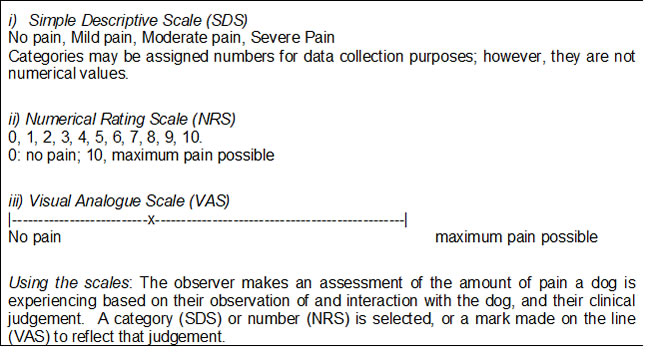
|
|
| |
Composite scales include the Glasgow Composite Measure Pain Scale and its short form (CMPS-SF), and the French Association for Animal Anaesthesia and Analgesia pain-scoring system, the 4A-Vet. The CMPS-SF, validated for use in measuring acute pain, is a clinical decision-making tool when used in conjunction with clinical judgement. Intervention level scores have been described (i.e., the score at which analgesia should be administered), thus it can be used to indicate the need for analgesic treatment. The instrument is available to download online. The 4A-Vet, which is also available online, is available for use in cats and dogs, although evidence for its validity and reliability have not yet been demonstrated. The Colorado State University (CSU) acute pain scale for the dog combines aspects of the numerical rating scale along with composite behavioural observation, and it has been shown to increase awareness of behavioural changes associated with pain. The University of Melbourne Pain Scale combines physiologic data and behavioural responses. Japanese Society of Study for Animal Pain Canine Acute Pain Scale (written in Japanese) is a numerical rating scale combined with behavioural observation and can be downloaded from the website. All of the composite scales above are easy to use and include interactive components and behavioural categories.